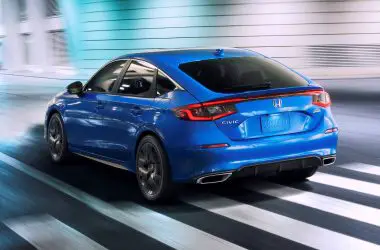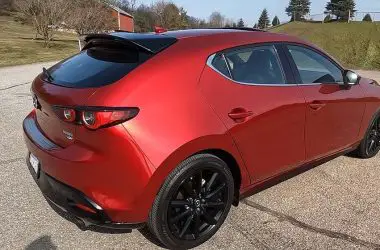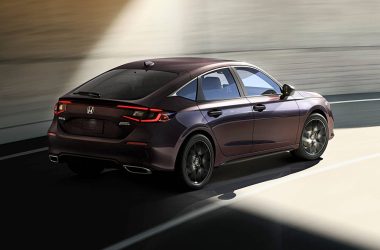In general, hatchbacks do tend to get better fuel economy than other vehicles of similar size and power. Here’s a look at why hatchbacks can be more fuel-efficient and some factors that impact their gas mileage.
Factors that affect fuel efficiency
Aerodynamics
One reason hatchbacks tend to get better fuel economy is their aerodynamic shape. Their short, truncated rear ends provide less wind resistance than traditional sedans. Less drag means the engine doesn’t have to work as hard to push the car through the air, resulting in better mileage.
Hatchbacks are smaller and lower than SUVs and minivans, with smoother profiles that slip through the air more easily. Compact size, sloped rear windows, and integrated spoilers all help reduce aerodynamic drag. Less turbulence means better fuel efficiency at highway speeds.
Lightweight Construction
In addition to their aerodynamic shape, most hatchbacks employ lightweight construction to reduce curb weight. High-strength steel, aluminum, and composite materials help pare down the pounds without sacrificing strength and rigidity. Some use lightweight polymer fuel tanks as well.
The less a vehicle weighs, the less effort the engine needs to get it moving and keep it going. By trimming excess weight, automakers can boost fuel economy without loss of performance, cargo space or safety. The most efficient hatchbacks weigh hundreds of pounds less than traditional sedans.
Transmission Options
Hatchbacks tend to offer fuel-sipping transmission choices to enhance efficiency. Many come standard with five- or six-speed manual gearboxes that allow drivers more control over engine revs and shift points. Sticking to lower rpms helps save gas.
Hatchbacks also offer continuously variable transmissions, which constantly adjust gear ratios for optimal efficiency. More are coming with new dual-clutch transmissions that quickly deliver power while eliminating losses between gears.
Turbocharged Smaller Engines
Today’s hatchbacks increasingly use petite turbocharged engines that provide big power while sipping less gas. Turbocharging allows automakers to use smaller displacement engines that produce the same or greater horsepower and acceleration as larger normally aspirated ones.
Because they have less internal friction and moving mass, downsized turbo engines typically return better fuel economy – 15-30% gains over traditional piston engines. Their power and torque at lower rpms enhances efficiency.
Engine Start-Stop Systems
Many hatchbacks now come with engine start-stop systems that shut off the engine when the car comes to a stop. Once the brake is released, the engine restarts instantly. By avoiding idling, start-stop technology can reduce fuel use by 3-10% in city driving.
The systems work so smoothly that they’re often imperceptible to the driver. Sensors and beefed up starters enable the engine to restart quickly and seamlessly when needed. Some systems can even turn the engine off when coasting downhill.
Regenerative Braking
Hatchbacks with hybrid and electric powertrains use regenerative braking to capture energy normally lost during braking. The electric motor acts as a generator to slow the vehicle and recharge the battery while coasting and braking.
By recycling movement into electricity instead of wasting it as heat, regenerative braking can boost fuel efficiency 10-25%. The extra electrical energy assists the engine so it doesn’t have to work as hard.
Cylinder Deactivation
Some hatchbacks employ cylinder deactivation to cut fuel consumption. This technology allows the engine computer to shut off half the cylinders when full power isn’t needed. Essentially turning a V6 into a V3 under light loads, cylinder deactivation can improve highway mileage by as much as 20%.
When more power is required, cylinders seamlessly reactivate. Advanced engine mounts and active noise cancellation make the transition imperceptible from inside the cabin. By operating on fewer cylinders, the engine uses less fuel.
Factors Impacting Hatchback MPG
While hatchbacks offer excellent fuel economy potential, there are factors that affect their real-world gas mileage. Driving style, added features and accessories can alter their efficiency.
Performance Versions
Automakers often produce hot hatch versions of their hatchbacks with more powerful engines, performance upgrades and sport-tuned suspensions. Models like the Honda Civic Si, Volkswagen GTI and Subaru WRX provide added pep for driving enthusiasts.
But the trade-off is fuel economy – performance hatches typically get 15-30% worse mileage than their more basic counterparts. Their engines sacrifice efficiency for speed and acceleration.
All-Wheel Drive
All-wheel drive improves traction and handing, especially in rain or snow. But it also impacts fuel efficiency. AWD systems add weight and mechanical losses that reduce mileage by up to 25% compared to front-wheel drive.
AWD disconnect systems found in some hatchbacks mitigate the losses by decoupling the rear axle when AWD isn’t needed. But there’s still an efficiency penalty associated with on-demand AWD systems.
Automatic Transmissions
Most hatchbacks offer the choice of manual or automatic transmissions. In the past, manuals delivered better mileage. But modern automatics have closed the gap thanks to more gears and lockup torque converters.
Today, automatics typically get only 1-2 mpg less than manuals. Continuously variable transmissions often return equal or better fuel economy. But manual models still allow more control over revs and shifting.
Bigger Wheels
Larger diameter wheels and shorter profile tires look sporty and improve handling. But they also reduce fuel economy. Upgrading from 15- to 18-inch wheels can cut gas mileage by around 3%, due to added rotational inertia.
Wider tires create more rolling resistance as well. So resist the temptation to upgrade wheel sizes unless the improved aesthetics or performance outweigh the impact on MPG.
Added Weight
Weighing down a hatchback with extras will take a toll on fuel economy. Heavy roof racks, bike carriers and cargo containers increase aerodynamic drag. All the extra weight forces the engine to work harder, increasing fuel consumption.
Even packing on the pounds will affect efficiency. An extra 100 lbs. of cargo or passenger weight can reduce mpg by up to 1%. So try to travel light for better economy.
Aggressive Driving
How and where you drive has the biggest impact on mileage. Aggressive driving with rapid acceleration, hard braking and excessive speed takes a big bite out of fuel efficiency. High speeds increase aerodynamic drag exponentially.
Driving smoothly while observing speed limits maximizes MPG. Cruise control helps maintain steady speeds without speeding as well. Avoiding excessive idling and minimizing use of energy-draining accessories also helps.
Hatchback MPG Comparison
While driving style plays a major role, the EPA fuel economy ratings of different hatchback models provide a useful comparison of their inherent efficiency. Here’s a look at some of the top-rated hatchbacks for combined city/highway driving:
| Make & Model | Combined MPG |
|---|---|
| Toyota Prius | 56 |
| Kia Niro Plug-In Hybrid | 46 |
| Kia Niro Hybrid | 50 |
| Toyota Corolla Hybrid | 53 |
| Honda Insight | 52 |
| Hyundai Ioniq Hybrid | 58 |
| Kia Forte | 33 |
| Toyota Matrix | 32 |
| Mini Cooper | 29 |
| Volkswagen Golf | 30 |
As the list shows, hybrid hatchbacks like the Prius and Insight deliver stellar fuel economy without sacrificing practicality. But even conventional gas-powered hatchbacks like the Kia Forte and VW Golf beat the 30+ mpg combined average for new cars.
How Driving Style Impacts Hatchback MPG
Driving habits make the biggest difference in hatchback fuel economy. Aggressive acceleration and speeding waste gas while eco-driving maximizes MPG. Here are some eco-driving tips to conserve fuel in a hatchback or any vehicle.
Gradual Acceleration
Flooring the accelerator guzzles gas, so accelerating gently is key. It takes time for momentum to build, so resist the urge to speed through every light. Timing it right avoids unnecessary stops.
Accelerating moderately uses less fuel reaching speed. Aim for 2 seconds from 0-30 mph. Keep it smooth with no jackrabbit jumps in speed.
Engine Warm Up
Modern engines don’t need warming up before driving. Gentle driving while avoiding high revs in cold weather allows the hatchback’s engine and transmission to warm up quickly.
Idling wastes fuel and takes longer to warm up systems. The best warm up is driving immediately at moderate speeds.
Maintain Steady Speeds
Speeding up and slowing down constantly hurts MPG. Use cruise control on highways to maintain a fuel-efficient constant speed.
On surface streets, timed acceleration and coasting to lights helps maintain momentum without braking. Flowing smoothly uses less gas than surging and braking.
Coast to Stops
Instead of braking hard, take your foot off the accelerator early and coast smoothly to stops. Timing lights right avoids complete stops when possible.
Also avoid inefficient micro stops and starts in heavy traffic. Look ahead to time it right. Less braking prevents wasted energy.
Easy on the Brakes
Braking burns up the kinetic energy your engine produces, so ease into stops. Give yourself plenty of room and time to brake gently.
Following closely wastes fuel when you have to brake constantly. Anticipating stops and lights allows gentle braking while conserving momentum.
Limit Idling
Idling gets 0 mpg. So turn off the engine if stopped for more than 30-60 seconds, like waiting for someone. Stop-start systems do this automatically.
Avoid drive-thrus and excessive idling to maximize MPG. Alsopark and shut off rather than idle curbside.
Light Accelerator Pressure
Easy does it on the gas pedal. A light touch accelerates sufficiently without sending consumption soaring.
Aggressive pedal pressure just wastes fuel. Finesse it like a gas sipper, not a powerhouse. Patience pays.
Optimize Gear Shifting
Shift up earlier and use higher gears for efficient cruising. High revs waste gas. Shift below 2500 rpm in a manual.
Use a lower gear on grades to avoid laboring the engine. Manuals provide more control but modern automatics work well.
Performance Mode
Sport and performance settings sacrifice efficiency for speed. Use sparingly and only when needed for passing or merging.
Eco mode optimizes powertrain components for maximum MPG. Normal mode offers a good blend of power and economy.
Speed Limits
Obey speed limits and avoid speeding over 65 mph. Aerodynamic drag increases exponentially at higher speeds, killing MPG.
Use cruise control on highways to avoid speed creep. Moderate speeds maximize economy while still moving along with traffic.
The Verdict on Hatchback Efficiency
For a vehicle type that provides outstanding utility and driving enjoyment, today’s hatchbacks offer fuel efficiency on par with many traditional sedans and small cars. By choosing a hatchback over an SUV or minivan, drivers can enjoy savings at the pump without sacrificing comfort or cargo versatility.
While driving style and options can impact MPG, most hatchbacks deliver a winning blend of performance and efficiency. So for shoppers looking for a practical vehicle with lower running costs, hatchbacks provide excellent fuel economy along with their iconic styling and cargo flexibility.




